Parks and protected areas are often created with the dual goal of protecting wildlife and the habitats within which they live, while also providing awe-inspiring recreational experiences to humans. In recent years human recreation within protected areas has been increasing worldwide, leading to poorly understood yet increasing impacts upon the wildlife within these parks (1–4). In addition to recreational impacts, multiple confounding stressors are imposed on wildlife by anthropogenic alteration of habitat through both industrial and urban expansion, including indirect effects through climate change induced range shifts (5). Protected area management in British Columbia and beyond has historically operated with insufficient information about the potential impacts of recreational and other anthropogenic effects on wildlife, particularly on a spatially localised scale, thereby affording sub-optimal protection for these wild species. Through my master’s research in UBC’s Wildlife Coexistence Lab, I hope to provide information addressing the question: How does non-consumptive recreation impact medium and large bodied mammal species in Cathedral Provincial Park?
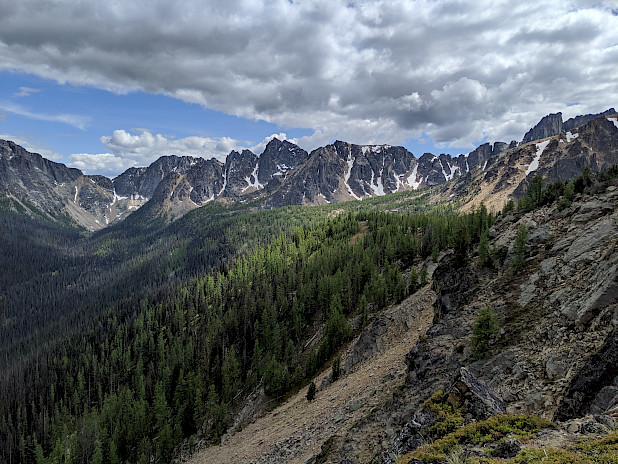
Cathedral Provincial Park is a unique protected area in the southern Okanagan, located in the traditional territory of the Syilx people. Spanning 330 square kilometers, and ranging from deep river valleys, to dense forests, to rocky alpine ridges, it is easy to see how this park is habitat for a vast range of species. This unique landscape also attracts a growing number of visitors throughout the year, particularly with access eased by private 4x4 shuttles offered into the subalpine core of the park for campers and lodge guests alike.
In order to explore the shared use of habitat by humans and wildlife through both space and time, we have deployed 50 camera traps distributed randomly throughout the park. A subset of these camera traps were deployed at randomly selected points along trails, providing data on the species and number of animals passing by, while also allowing us to quantify human use of the exact same trails. The remaining cameras were deployed at random points off-trail, ranging in distance from 400 meters to multiple kilometers from the nearest human use. By utilizing both of these camera site types, we are able to distinguish two important factors:
- How much and when are people using this area of habitat? (for on-trail cameras)
- How does animal use of habitat through space and time change depending on human use?
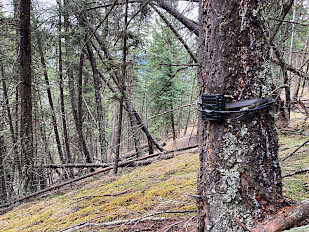
While we are yet to conduct statistical analyses of our data to answer these questions, we are busy processing images as cameras become accessible after the winter. So far we have been blown away at the diversity in species we’ve captured on our camera traps, including pika, cougars, moose, bears, and of course the mountain goats which Cathedral park is famed for. We are also amazed by the sheer number of humans using the trail network throughout the core area of the park.
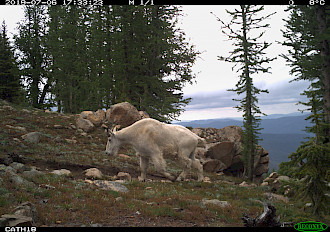 |
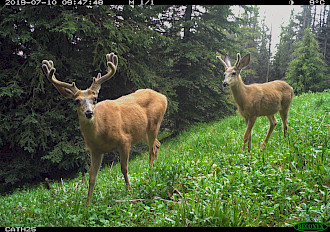 |
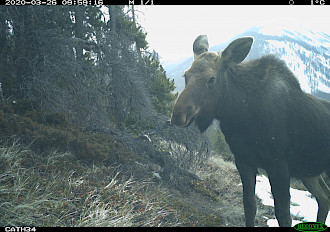 |
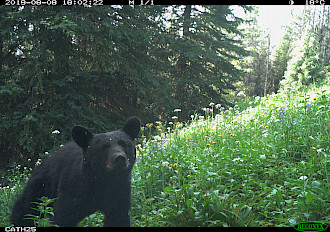 |
Above: examples of diverse fauna in Cathedral Provincial Park.
From this study we hope to be able to provide insight as to the relationship between human recreation and wildlife in protected areas, both in Cathedral Provincial Park and other protected areas throughout British Columbia. We are excited to work collaboratively with both BC Parks and First Nations on this project. Additionally, we’re inspired by the prospect for increasingly informed management of these special areas to help foster coexistence, while meeting the dual goals we began with; protecting wildlife and their habitats, while providing amazing experiences for people too.
About the author
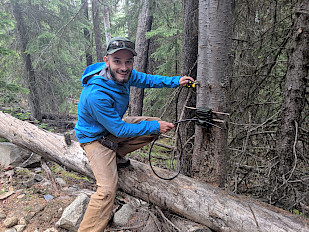 Mitch Fennell is an MSc student at the University of British Columbia, in the Wildlife Coexistence Lab. Prior to beginning studies at UBC he conducted research on human impacts on mesocarnivores in the lower mainland, acid precipitation on freshwater fish in BC, and habitat influences on wolf predation in Banff National Park. He is passionate about fostering coexistence between animals and humans, as well as integrating Traditional Ecological Knowledge with western science.
Mitch Fennell is an MSc student at the University of British Columbia, in the Wildlife Coexistence Lab. Prior to beginning studies at UBC he conducted research on human impacts on mesocarnivores in the lower mainland, acid precipitation on freshwater fish in BC, and habitat influences on wolf predation in Banff National Park. He is passionate about fostering coexistence between animals and humans, as well as integrating Traditional Ecological Knowledge with western science.
References:
1. Balmford A, Green JMH, Anderson M, Beresford J, Huang C, Naidoo R, et al. Walk on the Wild Side: Estimating the Global Magnitude of Visits to Protected Areas. PLOS Biol. 2015;24;13(2):e1002074.
2. Buckley R. Parks and Tourism. PLOS Biol. 2009;7(6):e1000143.
3. Reed SE, Merenlender AM. Quiet, Nonconsumptive Recreation Reduces Protected Area Effectiveness: Quiet recreation in protected areas. Conserv Lett. 2008;1(3):146–54.
4. Larson CL, Reed SE, Merenlender AM, Crooks KR. A meta‐analysis of recreation effects on vertebrate species richness and abundance. Conserv Sci Pract. 2019;1(10).
5. Johnson C, Balmford A, Brook B, Buettel J, Galetti M, Lei G, et al. Biodiversity losses and conservation responses in the Anthropocene. SCIENCE. 2017;356(6335):270–4.